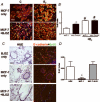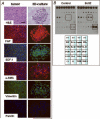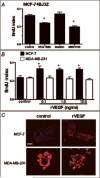Vascular endothelial growth factor secreted by activated stroma enhances angiogenesis and hormone-independent growth of estrogen receptor-positive breast cancer
- PMID: 20332242
- PMCID: PMC2848872
- DOI: 10.1158/0008-5472.CAN-09-4373
Vascular endothelial growth factor secreted by activated stroma enhances angiogenesis and hormone-independent growth of estrogen receptor-positive breast cancer
Abstract
"Reactive" or activated stroma characterizes many malignancies including breast cancers. Recently, we isolated a reactive mouse mammary gland stromal cell line called BJ3Z. These cells express alpha-smooth muscle actin and stromal cell-derived factor 1 (SDF-1) and are tumorigenic when injected into mice. Here we show that, in vivo, BJ3Z cells influence the angiogenesis and proliferation of xenografted estrogen receptor (ER)-positive MCF-7 human breast cancer cell-derived solid tumors. The growth-promoting effects of BJ3Z cells are equivalent to those of estradiol (E(2)). BJ3Z cells also increase the proliferation of normal mouse mammary luminal cells adjacent to tumors. In vitro, BJ3Z cells reorganize and increase the proliferation of cocultured malignant MCF-7 and normal human breast MCF10A cells grown as organoids in three-dimensional culture. The effects of BJ3Z cells on MCF-7 cells are equivalent to those of E(2). In contrast, BJ3Z cells do not alter the growth of highly aggressive ER-negative MDA-MB-231 human breast cancer cells. We show that BJ3Z cells secrete vascular endothelial growth factor (VEGF). The growth of MCF-7 organoids induced by BJ3Z can be inhibited by antagonists of VEGF and SDF-1. Conversely, recombinant VEGF stimulates the proliferation of MCF-7, but not MDA-MB-231, organoids. We conclude that, in addition to angiogenesis, VEGF released by activated stroma increases the growth of ER-positive malignant epithelial cells and of adjacent normal epithelium. Because activated stroma can substitute for E(2) and fosters hormone-independent growth of ER-positive tumors, we suggest that breast cancers exhibiting intrinsic hormone resistance may respond to antiangiogenic therapies.
Figures





Similar articles
-
Malignant stroma increases luminal breast cancer cell proliferation and angiogenesis through platelet-derived growth factor signaling.BMC Cancer. 2014 Oct 1;14:735. doi: 10.1186/1471-2407-14-735. BMC Cancer. 2014. PMID: 25274034 Free PMC article.
-
Overexpression of vascular endothelial growth factor by MCF-7 breast cancer cells promotes estrogen-independent tumor growth in vivo.Cancer Res. 2003 Aug 1;63(15):4684-91. Cancer Res. 2003. PMID: 12907650
-
Tamoxifen, flaxseed, and the lignan enterolactone increase stroma- and cancer cell-derived IL-1Ra and decrease tumor angiogenesis in estrogen-dependent breast cancer.Cancer Res. 2011 Jan 1;71(1):51-60. doi: 10.1158/0008-5472.CAN-10-2289. Epub 2010 Nov 19. Cancer Res. 2011. PMID: 21097717
-
Impact of aging on the biology of breast cancer.Crit Rev Oncol Hematol. 2008 Apr;66(1):65-74. doi: 10.1016/j.critrevonc.2007.09.001. Epub 2007 Oct 18. Crit Rev Oncol Hematol. 2008. PMID: 17949989 Free PMC article. Review.
-
Stroma in breast development and disease.Semin Cell Dev Biol. 2010 Feb;21(1):11-8. doi: 10.1016/j.semcdb.2009.10.003. Epub 2009 Oct 24. Semin Cell Dev Biol. 2010. PMID: 19857593 Free PMC article. Review.
Cited by
-
Dyskerin depletion increases VEGF mRNA internal ribosome entry site-mediated translation.Nucleic Acids Res. 2013 Sep;41(17):8308-18. doi: 10.1093/nar/gkt587. Epub 2013 Jul 1. Nucleic Acids Res. 2013. PMID: 23821664 Free PMC article.
-
p16INK4A represses breast stromal fibroblasts migration/invasion and their VEGF-A-dependent promotion of angiogenesis through Akt inhibition.Neoplasia. 2012 Dec;14(12):1269-77. doi: 10.1593/neo.121632. Neoplasia. 2012. PMID: 23308058 Free PMC article.
-
The metastasis inducer CCN1 (CYR61) activates the fatty acid synthase (FASN)-driven lipogenic phenotype in breast cancer cells.Oncoscience. 2016 Jul 22;3(7-8):242-257. doi: 10.18632/oncoscience.314. eCollection 2016. Oncoscience. 2016. PMID: 27713913 Free PMC article.
-
Effects of propofol/remifentanil-based total intravenous anesthesia versus sevoflurane-based inhalational anesthesia on the release of VEGF-C and TGF-β and prognosis after breast cancer surgery: a prospective, randomized and controlled study.BMC Anesthesiol. 2018 Sep 22;18(1):131. doi: 10.1186/s12871-018-0588-3. BMC Anesthesiol. 2018. PMID: 30243294 Free PMC article. Clinical Trial.
-
Immunization of stromal cell targeting fibroblast activation protein providing immunotherapy to breast cancer mouse model.Tumour Biol. 2016 Aug;37(8):10317-27. doi: 10.1007/s13277-016-4825-4. Epub 2016 Feb 3. Tumour Biol. 2016. PMID: 26842926
References
-
- Jacobsen BM, Harrell JC, Jedlicka P, Borges VF, Varella-Garcia M, Horwitz KB. Spontaneous fusion with, and transformation of mouse stroma by, malignant human breast cancer epithelium. Cancer Res. 2006;66:8274–9. - PubMed
-
- Woodward TL, Xie JW, Haslam SZ. The role of mammary stroma in modulating the proliferative response to ovarian hormones in the normal mammary gland. J Mammary Gland Biol Neoplasia. 1998;3:117–31. - PubMed
-
- Weaver VM, Gilbert P. Watch thy neighbor: cancer is a communal affair. J Cell Sci. 2004;117:1287–90. - PubMed
Publication types
MeSH terms
Substances
Grants and funding
LinkOut - more resources
Full Text Sources
Medical
Miscellaneous

